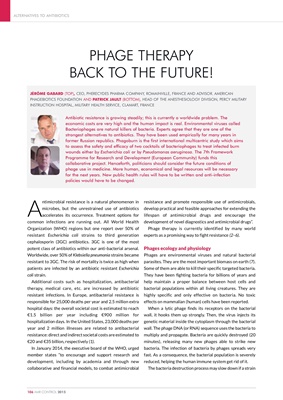
ALTERNATIVES TO ANTIBIOTICS
106 AMR CONTROL 2015
A
ntimicrobial resistance is a natural phenomenon in
microbes, but the unrestrained use of antibiotics
accelerates its occurrence. Treatment options for
common infections are running out. All World Health
Organization (WHO) regions but one report over 50% of
resistant Escherichia coli strains to third generation
cephalosporin (3GC) antibiotics. 3GC is one of the most
potent class of antibiotics within our anti-bacterial arsenal.
Worldwide, over 50% of Klebsiella pneumonia strains became
resistant to 3GC. The risk of mortality is twice as high when
patients are infected by an antibiotic resistant Escherichia
coli strain.
Additional costs such as hospitalization, antibacterial
therapy, medical care, etc. are increased by antibiotic
resistant infections. In Europe, antibacterial resistance is
responsible for 25,000 deaths per year and 2.5 million extra
hospital days: the overall societal cost is estimated to reach
€1.5 billion per year including €900 million for
hospitalization days. In the United States, 23,000 deaths per
year and 2 million illnesses are related to antibacterial
resistance: direct and indirect societal costs are estimated to
€20 and €35 billion, respectively (1).
In January 2014, the executive board of the WHO, urged
member states "to encourage and support research and
development, including by academia and through new
collaborative and financial models, to combat antimicrobial
resistance and promote responsible use of antimicrobials,
develop practical and feasible approaches for extending the
lifespan of antimicrobial drugs and encourage the
development of novel diagnostics and antimicrobial drugs".
Phage therapy is currently identified by many world
experts as a promising way to fight resistance (2-6).
Phages ecology and physiology
Phages are environmental viruses and natural bacterial
parasites. They are the most important biomass on earth (7).
Some of them are able to kill their specific targeted bacteria.
They have been fighting bacteria for billions of years and
help maintain a proper balance between host cells and
bacterial populations within all living creatures. They are
highly specific and only effective on bacteria. No toxic
effects on mammalian (human) cells have been reported.
When a lytic phage finds its receptors on the bacterial
wall, it hooks them up strongly. Then, the virus injects its
genetic material inside the cytoplasm through the bacterial
wall. The phage DNA (or RNA) sequence uses the bacteria to
multiply and propagate. Bacteria are quickly destroyed (20
minutes), releasing many new phages able to strike new
bacteria. The infection of bacteria by phages spreads very
fast. As a consequence, the bacterial population is severely
reduced, helping the human immune system get rid of it.
The bacteria destruction process may slow down if a strain
PHAGE THERAPY
BACK TO THE FUTURE!
JÉRÔME GABARD (TOP), CEO, PHERECYDES PHARMA COMPANY, ROMAINVILLE, FRANCE AND ADVISOR. AMERICAN
PHAGEBIOTICS FOUNDATION AND PATRICK JAULT (BOTTOM), HEAD OF THE ANESTHESIOLOGY DIVISION, PERCY MILITARY
INSTRUCTION HOSPITAL, MILITARY HEALTH SERVICE, CLAMART, FRANCE
Antibiotic resistance is growing steadily; this is currently a worldwide problem. The
economic costs are very high and the human impact is real. Environmental viruses called
Bacteriophages are natural killers of bacteria. Experts agree that they are one of the
strongest alternatives to antibiotics. They have been used empirically for many years in
former Russian republics. Phagoburn is the first international multicentric study which aims
to assess the safety and efficacy of two cocktails of bacteriophages to treat infected burn
wounds either by Escherichia coli or by Pseudomonas aeruginosa. The 7th Framework
Programme for Research and Development (European Community) funds this
collaborative project. Henceforth, politicians should consider the future conditions of
phage use in medicine. More human, economical and legal resources will be necessary
for the next years. New public health rules will have to be written and anti-infection
policies would have to be changed.